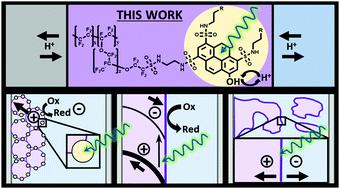当前位置:
X-MOL 学术
›
Energy Environ. Sci.
›
论文详情
Our official English website, www.x-mol.net, welcomes your
feedback! (Note: you will need to create a separate account there.)
Clarification of mechanisms of protonic photovoltaic action initiated by photoexcitation of strong photoacids covalently bound to hydrated Nafion cation-exchange membranes wetted by aqueous electrolytes
Energy & Environmental Science ( IF 32.4 ) Pub Date : 2021-07-21 , DOI: 10.1039/d1ee00482d Simon Luo 1, 2, 3, 4 , William White 1, 2, 3, 4 , Joseph M. Cardon 1, 2, 3, 4 , Shane Ardo 1, 2, 3, 4, 5
Energy & Environmental Science ( IF 32.4 ) Pub Date : 2021-07-21 , DOI: 10.1039/d1ee00482d Simon Luo 1, 2, 3, 4 , William White 1, 2, 3, 4 , Joseph M. Cardon 1, 2, 3, 4 , Shane Ardo 1, 2, 3, 4, 5
Affiliation

|
Junctions that form at interfaces of electronic semiconductors can lead to space–charge regions, which when properly designed result in diode behavior through current rectification. Space–charge regions are not unique to semiconductor interfaces and also form at ion-exchange-membrane interfaces, with properties that can be tuned by varying the concentration of ions in the contacting phases. Using this as a guide, and motivated by traditional dye-sensitized solar cells, we bathed photoacid-dye-sensitized cation-exchange membranes in aqueous solutions of varied electrolyte concentration and analyzed them for their ability to exhibit photovoltaic action. As predicted by Donnan membrane theory and semiconductor diode theory, the thermodynamic properties of each contacting phase determined the magnitude and sign of the net built-in electric potential difference. Measured open-circuit photovoltages were directly related to these electric potential differences, albeit the sign of the photovoltages was opposite (“reverse”) of that expected based on the sign of net electric potential differences across the membrane. Mechanistic details gleaned using transient absorption spectroscopy indicate that our photoacid dyes only photogenerate protons as the mobile charged species. Because our dye-sensitized cation-exchange membranes were infiltrated with protons, this means that minority-carrier hydroxides were not able to elicit photovoltaic action by standard minority-carrier-dominated effects. Instead, measured photovoltages are consistent with charge separation of a proton from its photoacid conjugate base that is driven by intrinsic liquid-junction-forming crossover of acid, which results in bulk membrane polarization and “reverse” photovoltaic action. These observations inform design guidelines for the use of water as a protonic semiconductor in devices for light-to-ionic power conversion.
中文翻译:

澄清由共价结合到水电解质润湿的水合 Nafion 阳离子交换膜上的强光酸的光激发引发的质子光伏作用机制
在电子半导体界面形成的结会导致空间电荷区,如果设计得当,会通过电流整流产生二极管行为。空间电荷区不是半导体界面所独有的,也会在离子交换膜界面上形成,其性质可以通过改变接触相中的离子浓度来调整。以此为指导,并受传统染料敏化太阳能电池的启发,我们将光酸染料敏化阳离子交换膜浸泡在不同电解质浓度的水溶液中,并分析它们表现出光伏作用的能力。正如唐南膜理论和半导体二极管理论所预测的那样,每个接触相的热力学特性决定了净内置电势差的大小和符号。测得的开路光电压与这些电势差直接相关,尽管光电压的符号与基于跨膜净电势差的符号所预期的符号相反(“反向”)。使用瞬态吸收光谱收集的机械细节表明,我们的光酸染料仅光生成质子作为可移动的带电物质。因为我们的染料敏化阳离子交换膜被质子渗透,这意味着少数载流子氢氧化物不能通过标准的少数载流子主导效应引发光伏作用。反而,测量的光电压与质子与其光酸共轭碱的电荷分离一致,这是由酸的内在液体结形成交叉驱动的,这导致体膜极化和“反向”光伏作用。这些观察结果为在光到离子能量转换设备中使用水作为质子半导体的设计指南提供了信息。
更新日期:2021-08-02
中文翻译:

澄清由共价结合到水电解质润湿的水合 Nafion 阳离子交换膜上的强光酸的光激发引发的质子光伏作用机制
在电子半导体界面形成的结会导致空间电荷区,如果设计得当,会通过电流整流产生二极管行为。空间电荷区不是半导体界面所独有的,也会在离子交换膜界面上形成,其性质可以通过改变接触相中的离子浓度来调整。以此为指导,并受传统染料敏化太阳能电池的启发,我们将光酸染料敏化阳离子交换膜浸泡在不同电解质浓度的水溶液中,并分析它们表现出光伏作用的能力。正如唐南膜理论和半导体二极管理论所预测的那样,每个接触相的热力学特性决定了净内置电势差的大小和符号。测得的开路光电压与这些电势差直接相关,尽管光电压的符号与基于跨膜净电势差的符号所预期的符号相反(“反向”)。使用瞬态吸收光谱收集的机械细节表明,我们的光酸染料仅光生成质子作为可移动的带电物质。因为我们的染料敏化阳离子交换膜被质子渗透,这意味着少数载流子氢氧化物不能通过标准的少数载流子主导效应引发光伏作用。反而,测量的光电压与质子与其光酸共轭碱的电荷分离一致,这是由酸的内在液体结形成交叉驱动的,这导致体膜极化和“反向”光伏作用。这些观察结果为在光到离子能量转换设备中使用水作为质子半导体的设计指南提供了信息。











































 京公网安备 11010802027423号
京公网安备 11010802027423号